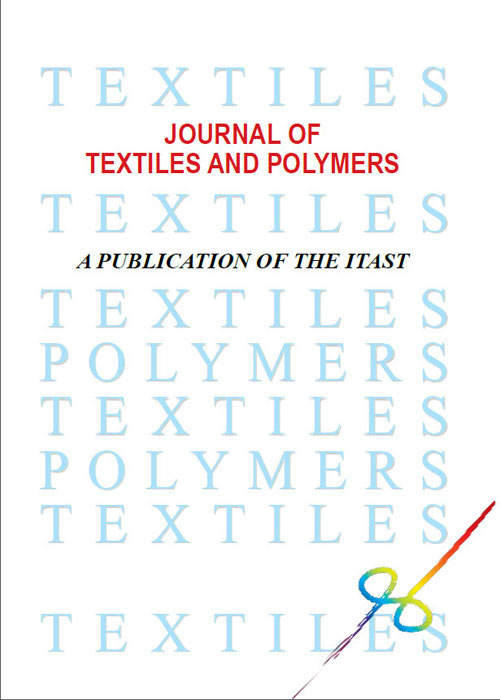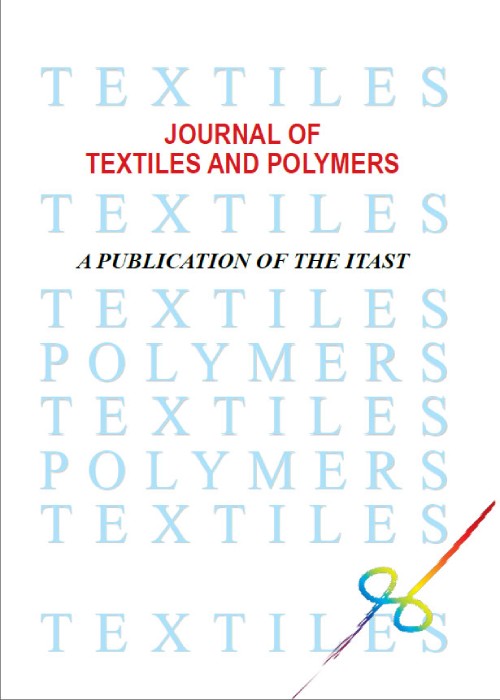فهرست مطالب

Journal of Textiles and Polymers
Volume:8 Issue: 1, Winter 2020
- تاریخ انتشار: 1398/11/15
- تعداد عناوین: 7
-
-
Pages 3-16
Preparation of durable cotton fabrics with multifunctional properties has been lately the center of researchers’ attention and also utilizing nanoparticles is an effective strategy to gain this target. Here, acid cellulase enzyme in ultrasonic bath and nano-TiO2 sonoloading were utilized on cotton fabric to obtain self-cleaning, antifungal, protection against ultra-violet and x-linking features on fabric. Also, statistical design of D-optimal was applied for variables of time, temperature, acid cellulase, and TiO2 nanoparticles concentrations in ultrasonic bath. Laundering durability was measured for prepared cotton samples and discussed in optimized conditions using response surface methodology. Also, reflectance spectra analyses (200-400 nm), scanning electron microscopy, and energy-dispersive X-ray (EDX) were employed to confirm TiO2 nanoparticles presence on treated cotton surfaces. The research results reveal that durable multifunctional properties including color difference amounts (24.09), antifungal activity against Candida albicans (98.51%), ultra-violet protection factor (45.13), and dry crease recovery angle (256.3°) are significantly high at optimized condition (cellulase enzyme: 1.32%, Temperature: 60 °C, Time: 31.1 min, TiO2 nanoparticles: 1.07%) as compared with blank sample.
Keywords: cellulase, durability, TiO2 nanoparticles, response surface methodology -
Pages 17-36
Electrospinning (ES) is a process affected by different factors including solutions, apparatus, and environmental parameters. Selecting ES parameters having effects on final scaffold properties is a multicriteria decision-making problem. The use of statistical methods for multi-criteria decision-making can save time, energy and cost of the process and improve the efficiency of the final product. So in this study, the fuzzy VIKOR method with Shannon entropy weighting method was used for optimizing electrospun scaffold for bone tissue healing. For this, in the first step by trial and error, the percentage of polycaprolactone (PCL) in solution was selected. Then composite scaffolds were prepared with different hydroxyapatite (HA) concentrations and ES parameters (flow rate, ES distance, and the voltage). ES parameters, as well as HA concentration affected the studied characteristics of scaffolds. The obtained data were used for deploying weights of seven criteria based on Shannon entropy concept in fuzzy method optimization. Fiber diameter and distribution, surface and volume porosity, fiber alignment, surface roughness, and stable ES process were the 7 criteria considered in this study and 40 electrospun scaffolds were ranked with the fuzzy method by these criteria, then best-ranked samples redesigned. The redesigned samples were studied with SEM, AFM, TGA, Raman spectroscopy, water contact angle, tensile test, MTT assay, live/dead cells, and ALP activity tests. The diameter of the redesigned optimized scaffolds was obtained between 204 and 13 nm; and the surface and volume porosity were 67%-91% and 65%-86%, respectively. No toxicity was found and scaffolds had a positive effect on cell growth.
Keywords: electrospinning, PCL, HA scaffold, engineered textile, hard tissue engineering, fuzzy modeling -
Pages 37-42
In this research, the anti-fungal effect of fluconazoleloaded polyvinyl alcohol (PVA) nano-fibers was compared with that of drug-loaded fabric (DLF) to be used in medical textiles and fibrous pads as a local drug delivery system. The drug-loaded nano-fibers (DLNs) were coated on the fabric surface using the electro-spinning process. The DLF was then prepared by means of the pad-dry method. The characterization of the samples was carried out by SEM, FTIR, and XRD tests. UV-V is spectrophotometry was also used to measure the drug release rate. The anti-fungal effect was studied by the disk diffusion method. The drug release test showed about 75% fluconazole release in 90 min and the disc diffusion test indicated that the DLF has more effect than the DLN due to the fast drug release.
Keywords: nano-fibers, candida albicans, vulvovaginal candidiasis, fluconazole, drug delivery system -
Pages 43-52
Enset (Ensete ventricosum, family musaceae) is a plant of Ethiopia. Ethiopians are farmed enset plant for food uses. It is very similar to the banana plant (Musa acuminate, Family musaceae) and hence termed “false banana”. However, the starch of enset plant is stored in major quantities in the pseudostem and underground corms. The properties of the enset starch were not studied in detail. The native enset starch (ES) was evaluated for proximate composition and physicochemical properties. The enset starch properties, such as bulk density, tapped density, granule size, color of enset starch powder and gel, pH, swelling capacity, solubility, and gelatinization properties were examined. Sorption isotherm of enset starch was studied. The effect of NaCl and sucrose on swelling capacity, solubility and gelatinization properties has been examined. The kinetics of gelatinization of enset starch (starch:water weight ratio, 1:2) were investigated using differential scanning calorimetry (DSC).
Keywords: enset starch, physicochemical properties, native, gelatinization, kinetics, DSC -
Pages 53-63
The Poisson’s ratio is one of the fundamental properties of any engineering material and presents an essential mechanical aspect of them. The mechanical properties of fabrics as the most common type fibrous materials, especially the Poisson’s ratio, needs to be thoroughly studied. Sometimes the value of Poisson’s ratio obtained for fabrics differs significantly from the other engineering materials, which results in the unique performance of fabrics when subjected to the tensile deformations. Besides, due to the nature and exclusive structure of fabrics compared to the other sheet materials, the measurement methods of Poisson’s ratio and accuracy of the results have been always a matter that required special consideration. A detailed review of different measurement methods of the Poisson’s ratio of fabrics and also the relationship between this property and other physical and mechanical characteristics can be useful for the continuation of researches in this field.
Keywords: Poisson’s ratio, woven fabric, nonwoven, knitted fabric, mechanical properties -
Pages 65-74
Given the slogan for Iranian years 1397 and 1398 “supports the national production” and “production boom”, the impact of Iranian consumers buying behavior in their country’s economy has become an important issue. In this research, the Hacoupian Clothing Corporation has been selected as our case study to investigate this issue in the Iranian apparel industry. First, the effective variables and factors in changing the consumer buying behavior are identified by exploratory factor analysis method. Second, the impact of these variables and factors are analyzed on the Iranian apparel consumption by confirmatory factor analysis method and finally, a comprehensive model is presented to promote Iranian domestic consumption. Research findings reveal five prioritized effective factors that are changing consumer buying behavior toward Iranian apparel consumption. These factors are: 1. identity factors, 2. product differentiation, 3. consumer orientation, 4. marketing techniques, and 5. consumer relationship channels.
Keywords: iranian goods, consumer behavior, apparel industry, domestic consumption, factor analysis -
Pages 75-84
Threads or yarns are key building blocks in constructing complicated fibrous structures for many biomedical applications such as scaffolds to direct cells in tissue engineering applications. In this study, protein-loaded aligned fibers with core-shell structures were successfully fabricated by combining coaxial electrospinning with a rotating disk collector. A model protein, bovine serum albumin (BSA) as a core was incorporated into shell material, including PCL/gelatin (50:50) hybrid and then electrospun aligned core-shell fibers on the rotating disk. After manually twisting the aligned fiber bundle, the prepared threads were crosslinked with genipin. The fibers and thread morphologies were characterized by scanning electron microscopy (SEM), fluorescent microscopy (FM), transmission electron microscopy (TEM), and Fourier transform infrared spectroscopy (FTIR), and the threads tensile properties were then evaluated. The well-aligned fibers (with a mean diameter of 1.472±0.444 μm) with uniform core-shell structures without any bead formation and homogeneous protein incorporation into them were obtained using a rotating wheel at 1300 rpm.BSA-loaded threads with a diameter of 150-250 μm were finally prepared from aligned fiber bundle by keeping their well-aligned structure. The tensile tests revealed that fibrous thread with the modulus of 34.2 cN/tex had proper tensile properties for tissue engineering approaches. FTIR thus proved that the crosslinking was successful between thread and genipin. After crosslinking, threads retained their fibrous structure and demonstrated the improvement in the tensile properties (modulus increased to 40.64 cN/tex). These findings are promising to promote biomedical agents-loaded fibrous threads for tissue suturing and tissue regeneration applications.
Keywords: coaxial electrospinning, core-shell fiber, aligned fibers, fibrous thread


